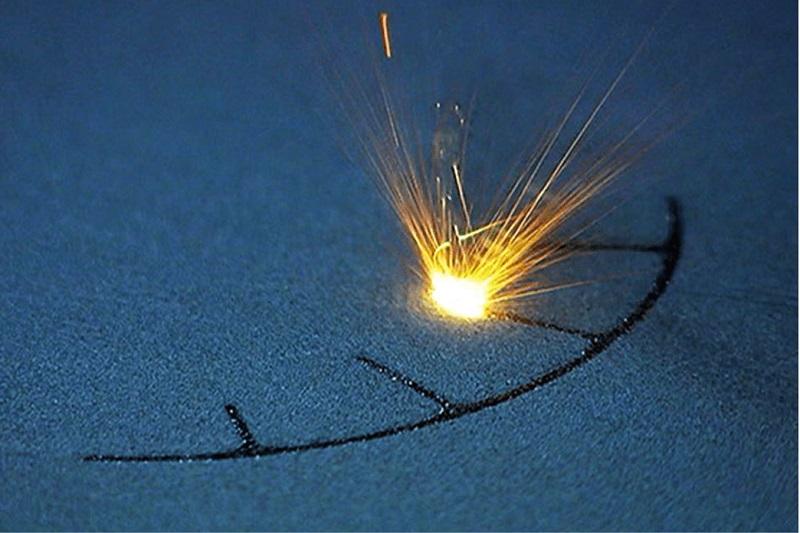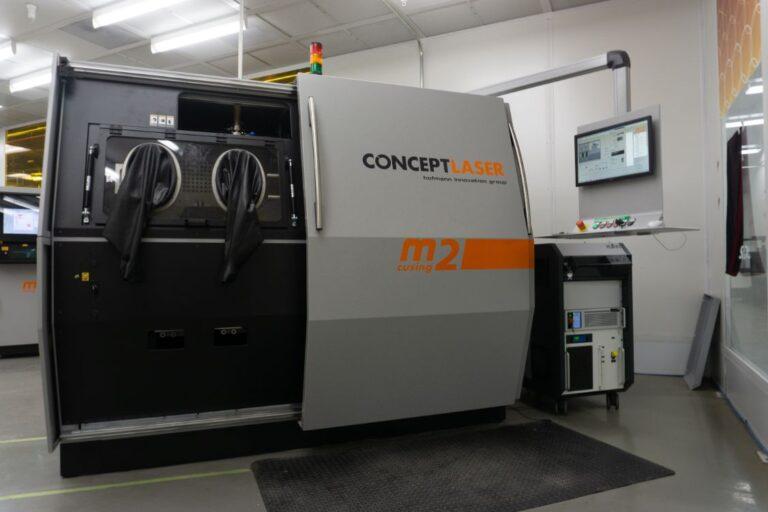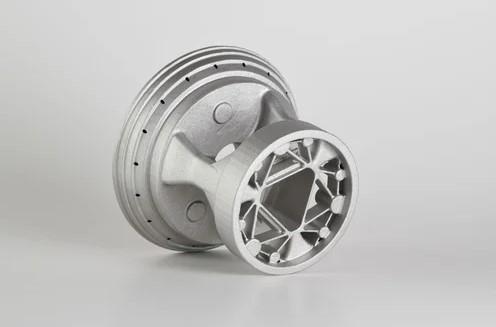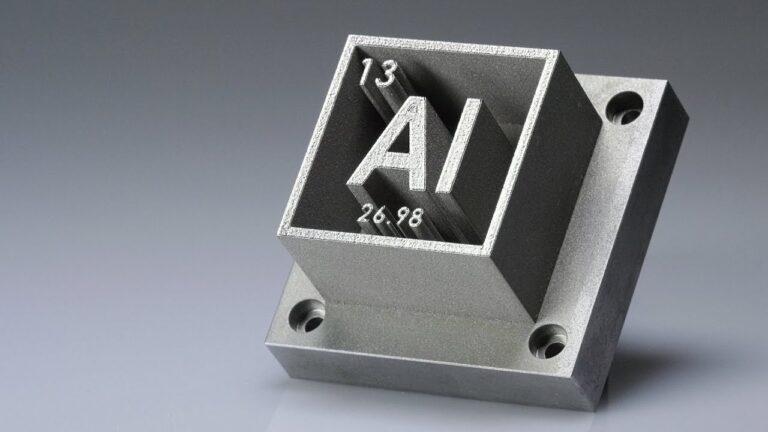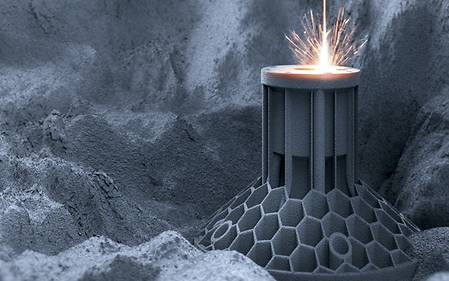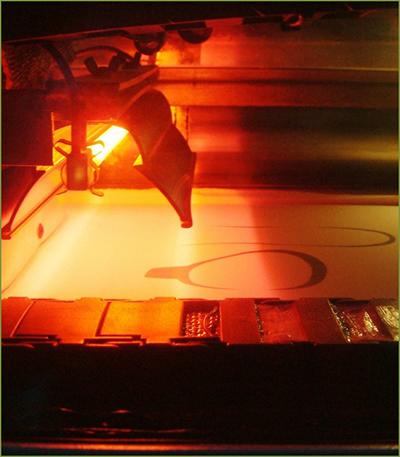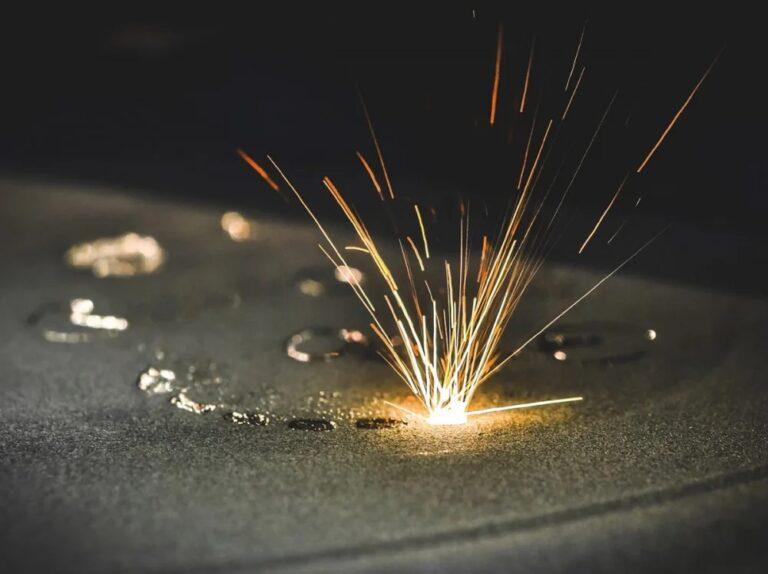Introduction
Laser Powder Bed Fusion is a rapidly evolving technology that is transforming the field of additive manufacturing. It involves the use of a laser to selectively fuse layers of powdered material together, allowing for the creation of complex geometries and customized designs. Laser Powder Bed Fusion has a wide range of applications, from aerospace and medical to automotive and jewelry industries. Laser Powder Bed Fusion creates highly accurate and precise parts. It reduces material waste and enhances design flexibility. LPBF is a preferred manufacturing method in many industries. This guide explores the principles, materials, advantages, and disadvantages of LPBF. It also covers the applications and future prospects of this technology.
Definition of Laser Powder Bed Fusion
In Laser Powder Bed Fusion, a laser selectively fuses layers of powdered material together. This process is a type of additive manufacturing. The process starts with the delivery of powdered material onto a build platform. A high-powered laser then scans the surface of the powder bed, selectively melting and fusing the material together according to a digital design file. The system completes each layer, then moves the build platform down and applies a new layer of powder. This process repeats until the final part is complete. The process allows for the creation of complex geometries and customized designs with high accuracy and precision. LPBF is a versatile technology. It has a wide range of applications. LPBF can be used for rapid prototyping. It is also used for the production of finished parts. It is used in industries such as aerospace, medical, and automotive.
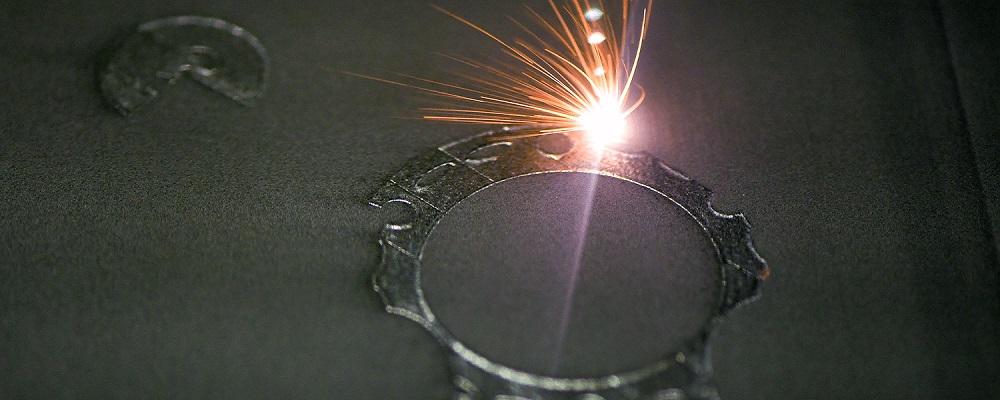
Brief history and evolution of the technology
Rapid prototyping introduced in the 1980s. Laser Powder Bed Fusion originated from it. Commercial LPBF devices became available in early 2000s. Substantial improvements made in LPBF technology. Laser power, scanning speed, and control systems improved significantly. The technology’s potential uses have grown as a result of the creation of new materials, including composites and metal alloys. Laser Powder Bed Fusion is a promising additive manufacturing technology. It is fast-developing. New developments and applications are appearing daily.
Importance and applications of LPBF
Laser Powder Bed Fusion is an essential technology with significant applications in various industries. Laser Powder Bed Fusion enables the creation of complex geometries and customized designs. The technology offers high accuracy and precision. It is valuable for rapid prototyping, product development, and the production of finished parts. The aerospace and medical industries are increasingly using Laser Powder Bed Fusion. These industries demand lightweight, durable, and customized parts.
It has also found use in the automotive, jewelry, and defense industries, among others. Laser Powder Bed Fusion can revolutionize manufacturing. It reduces waste and enhances productivity. It increases design freedom. As LPBF technology advances, it will become more important. It will have a significant impact on manufacturing industries.
How Laser Powder Bed Fusion Works
Laser Powder Bed Fusion is a cutting-edge additive manufacturing process that offers tremendous design freedom and precision. Understanding how Laser Powder Bed Fusion works is critical to unlocking its full potential in a wide range of applications. The process involves the selective melting and fusing of powdered material using a high-powered laser. Laser selectively melts and fuses each layer. Based on a digital design file. Creates a complex, customized part. Involves powder delivery, build platform, laser system, and control system. Understanding LPBF and components helps appreciate its benefits.
Principles of Laser Powder Bed Fusion
Laser Powder Bed Fusion uses selective laser melting.Laser melts and fuses powder to form solid parts. The process begins with the delivery of a thin layer of powdered material onto a build platform. The laser scans the surface of the powder bed. It melts and fuses the material. The process follows a digital design file. Repeat the process layer by layer until completing the final part. Precisely control the laser power, scanning speed, and powder delivery system to ensure the desired level of accuracy and precision. Laser Powder Bed Fusion allows complex geometries and customized designs with high precision. It’s valuable for many applications.
Overview of the process
The Laser Powder Bed Fusion process involves several stages, beginning with the preparation of the build platform. A powder delivery system is then used to put a thin layer of powdered material on the platform. The laser scans the powder bed surface. It selectively melts and fuses the material. This is based on a digital design file.
The laser system completes each layer, and then the build platform moves down while adding a new layer of powder. This process continues until the final part is complete. The laser power, scanning speed, and powder delivery are carefully controlled. This achieves the necessary level of precision and accuracy. The user removes the part from the build platform after completion and conducts post-processing to remove excess powder. Sandblasting or bead blasting is involved in the process. Laser Powder Bed Fusion allows for precise custom designs. This makes it a useful tool for a wide range of uses.
Components of Laser Powder Bed Fusion technology
Laser Powder Bed Fusion technology comprises a few key parts that work together to create precise parts. These parts include the powder delivery system, build platform, laser system, and control system. The powder delivery system delivers powder uniformly onto the build platform. It ensures a consistent foundation for the laser to fuse the material. The build platform offers a foundation for the part being built and moves down as each layer is completed.
A high-powered laser is delivered by the laser system. It selectively melts and fuses material. Precise control is ensured over the process. The control system coordinates the movements of the laser and build platform. It ensures that the correct amount of material fuses together in the right place. The components must work seamlessly. They produce high-quality parts with precision. Laser Powder Bed Fusion is valuable. It is a tool for many applications.
Powder delivery system
The powder delivery system is an important part of Laser Powder Bed Fusion technology. Its job is to put a layer of powder on the build platform that is consistent and even. Usually, a powder reservoir, a powder distribution system, and a recoater blade make up the system. The material used to build the part is held in the powder reservoir. The powder distribution system delivers the material from the reservoir onto the build platform. The system ensures that the material is evenly distributed across the surface.
The recoater blade smooths powder on the platform, ensuring a level and uniform layer. By adjusting the system’s delivery of powder, it is possible to change the thickness of each layer. A well-designed powder delivery system is essential for producing high-quality parts with a smooth and even surface finish. Proper control of powder flow rate and distribution is essential for accurate and precise laser fusing. It ensures the desired part geometry.
Build platform
Laser Powder Bed Fusion technology uses an important part known as the build platform. The build platform provides a stable base for the part under construction. Build platforms are made from heat-resistant materials. Manufacturers use aluminum or ceramic. The platform is usually a flat plate. The operator puts the powder on the flat and level surface of the platform. After completing each layer, the platform moves down by a small amount. The addition of a new layer of powder is possible through this movement, and the process repeats. The temperature of the platform is heated just below the melting point of the material being used.
The material must melt and fuse together effectively. This prevents warping or distortion of the part. This is due to thermal expansion. Level and smooth surfaces are necessary on the build platform. This ensures accurate and consistent deposition of each layer of material. Engineers designed the build platform to enable easy removal of the part and removal of excess powder through post-processing methods. Maintenance and calibration are crucial for the build platform. High-quality parts require accurate geometry and smooth surface finish.
Laser system
The laser system melts and fuses the powdered material together in Laser Powder Bed Fusion technology. It typically operates at several hundred watts to several kilowatts, providing a high-powered beam of light precisely focused on the powder bed. A set of mirrors and other optical elements steer the laser beam to the desired location on the powder bed. To ensure the desired level of accuracy and precision, the laser power, scanning speed, and spot size are carefully controlled. The laser system operates in a pulsed mode with each pulse lasting only a few nanoseconds. This allows for precise control of the energy delivered to the material. The laser system monitors powder bed temperature and adjusts laser power accordingly. It is enclosed to prevent operator exposure to high-powered laser beams. Maintenance and calibration are essential for high-quality parts.
Control system
The control system coordinates the laser and build platform in Laser Powder Bed Fusion technology. It includes a computer with specialized software for specifying part geometry and controlling build parameters. Sensors monitor the build platform position and powder bed temperature, giving feedback for the process.
The Laser Powder Bed Fusion technology has a control system that adjusts laser power and build platform speed. This ensures accurate deposition of each layer with the correct material amount. The control system has safety features like emergency stop buttons and interlocks to ensure the operator’s safety. The software is typically user-friendly, enabling users with minimal training to create complex parts with high accuracy. Proper maintenance and calibration of the control system is essential for producing high-quality parts.
Materials Used in Laser Powder Bed Fusion
Laser powder bed fusion tech allows for accurate small parts. A variety of materials can be used, including metals, alloys, ceramics, and polymers. Material selection affects final performance. In this section, we’ll discuss the features and applications of these materials. We’ll also talk about the pros and cons of working with them and how to make high-quality parts.
Overview of Materials used in Laser Powder Bed Fusion
Laser Powder Bed Fusion technology enables the production of complex parts with high precision and accuracy using a wide range of materials. Some of the most commonly used materials include metals and alloys such as titanium, stainless steel, aluminum, and nickel-based alloys. These materials have high strength, corrosion resistance, and other desirable properties, which make them ideal for a wide range of applications in industries like aerospace, automotive, and medical. We can also use other materials in Laser Powder Bed Fusion, including ceramics, polymers, and composites. Each material has its unique properties, and we select the material based on the specific requirements of the part that we want to produce. However, the use of certain materials in Laser Powder Bed Fusion can present challenges such as warping, cracking, and porosity. Therefore, proper material preparation and process parameters are essential to producing high-quality parts with the desired characteristics.
Types of materials used in Laser Powder Bed Fusion
The materials used in Laser Powder Bed Fusion can be classified into four main groups: metals and alloys, ceramics, polymers, and composites. People commonly use metals and alloys because of their excellent mechanical properties and thermal conductivity. Examples include titanium, stainless steel, aluminum, and nickel-based alloys. People use ceramics in Laser Powder Bed Fusion because they have high hardness, wear resistance, and biocompatibility.
Examples include zirconia, alumina, and hydroxyapatite. Polymers provide high flexibility and find extensive applications in several industries, such as aerospace and medical. Examples include nylon, polyetherimide, and polycarbonate. Composites consist of a combination of two or more materials to produce a material with unique properties. Examples of composite materials include carbon fiber-reinforced polymers (CFRPs) and glass fiber-reinforced polymers (GFRPs). The choice of material depends on the specific application, and each material group has its own unique properties and challenges associated with its use in Laser Powder Bed Fusion.
Metals and alloys
Metals and alloys are commonly used in Laser Powder Bed Fusion due to their excellent mechanical properties and thermal conductivity. They are flexible and can be used in a wide range of industries such as aerospace, automotive, and medical. Titanium, stainless steel, aluminum, and nickel-based alloys are some of the commonly used metals. Titanium is suitable for aerospace and medical applications due to its high strength, low density, and excellent corrosion resistance.
People widely use stainless steel because it has high strength, toughness, and corrosion resistance. The aerospace and automotive industries commonly use aluminum because it is lightweight. High strength and excellent corrosion resistance make nickel-based alloys suitable for high-temperature applications. Controlling the Laser Powder Bed Fusion process parameters can optimize the properties of each metal or alloy, resulting in parts with unique properties and characteristics.
Ceramics
People commonly use ceramics in Laser Powder Bed Fusion because they have high hardness, wear resistance, and biocompatibility. Ceramics withstand high temperatures and possess excellent electrical and thermal insulation properties, making them suitable for high-temperature environments or as insulators in electronic devices. Examples of ceramics used in Laser Powder Bed Fusion include zirconia, alumina, and hydroxyapatite. Dental and biomedical applications often use zirconia due to its high strength, biocompatibility, and aesthetic properties.
People use alumina in a variety of industrial applications because of its excellent mechanical and chemical properties. Hydroxyapatite, a bioceramic material, has excellent biocompatibility and can bond with natural bone tissue, which is why orthopedic and dental professionals use it. Ceramics can be challenging to process due to their high brittleness and tendency to crack under stress. However, Laser Powder Bed Fusion allows for the production of complex ceramic parts with precise dimensions and intricate geometries, opening up new possibilities for the use of ceramics in various industries.
Polymers
People use polymers in laser powder bed fusion because they have a high level of flexibility and versatility. They work well in situations where reducing weight and increasing chemical resistance are important factors. Nylon, polyetherimide, and polycarbonate are some of the polymers used in laser powder bed fusion. Nylon, which has excellent mechanical properties and can withstand high temperatures, is commonly used in the automotive industry.
Polyetherimide finds application in aerospace and electronic industries due to its strong heat resistance and superior electrical insulating qualities. Polycarbonate, on the other hand, is frequently used in the medical sector because of its biocompatibility and transparency. Polymers are difficult to treat due to poor heat conductivity and contraction during printing. Laser Powder Bed Fusion is promising for producing complex polymer components. Laser Powder Bed Fusion enables fabrication with precision and complex geometries.
Composites
Processing difficulties make composites a class of materials that laser powder bed fusion doesn’t often employ. Composites typically consist of a matrix material strengthened with fibers, particles, or other elements. The Composites are perfect for usage in sectors like aerospace, automotive, and sporting goods because they have special qualities including high strength, stiffness, and low weight. Composites include, for instance, glass fiber-reinforced polymers and carbon fiber-reinforced polymers (CFRP) (GFRP).
The aerospace industry makes extensive use of CFRP because of its high strength and stiffness. Because of its small weight and great impact resistance, GFRP is frequently employed in the automobile sector. Composites can be difficult to treat due to their anisotropic characteristics. They can cause warpage, porosity, and delamination during the printing process. Research is being done to create novel materials and processing methods. This will allow composites to be used in laser powder bed fusion.
Advantages and Disadvantages of Laser Powder Bed Fusion
Laser Powder Bed Fusion is a promising technology for the production of complex parts with high accuracy and precision. However, like any other manufacturing technology, it has its advantages and disadvantages. Knowing Laser Powder Bed Fusion pros and cons can help with manufacturing technology choices. This section covers Laser Powder Bed Fusion advantages and disadvantages. The discussion will highlight strengths and weaknesses of the technology.
Advantages of Laser Powder Bed Fusion
Laser Powder Bed Fusion has advantages over traditional manufacturing technologies. It is a popular choice for complex part production. High accuracy and precision is one of its main advantages. The layer-by-layer approach allows for complex geometries with high accuracy. Laser Powder Bed Fusion allows for production of intricate parts. It provides high material efficiency and minimal waste. It can produce parts with improved mechanical properties. These properties include higher strength and hardness. The fine microstructure of the printed parts is responsible for these improvements.
Design flexibility
One of the key advantages of Laser Powder Bed Fusion is its design flexibility. Laser Powder Bed Fusion allows for the production of parts with complex geometries and intricate features that would be difficult or impossible to produce using traditional manufacturing technologies. This is due to the layer-by-layer approach used in the printing process, which enables the production of complex geometries with high accuracy.
The ability to produce complex geometries and intricate features opens up new design possibilities, enabling engineers to optimize the design of parts for specific applications. This design flexibility also allows for the production of lightweight parts with optimized structural integrity, reducing weight and improving performance. Additionally, Laser Powder Bed Fusion allows producing parts with internal features, such as channels or voids, that can serve for fluid flow or other functions. Overall, the design flexibility of Laser Powder Bed Fusion makes it a powerful tool for the production of complex parts with high accuracy and precision.
Lattice structures
A good example of the design flexibility offered by Laser Powder Bed Fusion is the production of lattice structures. Lattice structures are complex geometries with an open framework that are difficult to produce using traditional manufacturing technologies. However, Laser Powder Bed Fusion enables the production of lattice structures with high accuracy and precision, due to its layer-by-layer approach. Using lattice structures can improve the performance of parts by reducing weight while maintaining structural integrity. In aerospace applications, lattice structures can reduce the weight of structural components, such as brackets or fittings, while maintaining their strength and stiffness. This not only reduces the weight of the aircraft but also improves fuel efficiency and reduces emissions. Therefore, the design flexibility offered by Laser Powder Bed Fusion is a powerful tool for engineers and manufacturers looking to optimize the design of parts for specific applications.
Reduced material waste
Laser Powder Bed Fusion reduces material waste compared to traditional manufacturing technologies. Traditional manufacturing technologies, such as machining or casting, waste significant amounts of material in the production process. They cut parts from larger blocks of material, resulting in significant material waste. However, Laser Powder Bed Fusion builds parts layer-by-layer from a bed of powder, reducing material waste by using only the necessary material to build the part and recycling any excess powder for future use.
Traditional manufacturing technologies can waste up to 80% of the material during the machining process, while Laser Powder Bed Fusion reduces material waste by up to 90% compared to traditional manufacturing technologies. This not only reduces the cost of production but also makes Laser Powder Bed Fusion a more sustainable manufacturing technology.
High accuracy and precision
Another advantage of Laser Powder Bed Fusion is its high accuracy and precision. Laser Powder Bed Fusion is capable of producing parts with extremely tight tolerances and intricate geometries that would be difficult or impossible to achieve using traditional manufacturing technologies. This is due to the fact that the process involves the precise deposition of a layer of powder followed by the accurate scanning of a laser beam, which melts and fuses the powder in a controlled manner.
High-resolution scanning systems used in the process attribute the accuracy and precision of Laser Powder Bed Fusion. These scanning systems are capable of controlling the size and shape of the laser beam, as well as the speed and direction of its movement. This enables precise control over the melting and fusing of the powder, which results in parts with high accuracy and precision.
In the aerospace industry, companies use Laser Powder Bed Fusion to produce complex turbine blades with intricate geometries and precise dimensions. These parts require high accuracy and precision to ensure optimal performance and efficiency. Laser Powder Bed Fusion enables the production of such parts with a high degree of accuracy and precision, which is essential for the aerospace industry.
Overall, the high accuracy and precision of Laser Powder Bed Fusion make it a valuable manufacturing technology for industries that require complex parts with tight tolerances and intricate geometries. The process enables the production of parts with exceptional quality and performance, which can improve the reliability and efficiency of various products and applications.
Customization and personalization
Laser Powder Bed Fusion technology also enables a high level of customization and personalization. Since the process is entirely digital, designers can create and customize parts quickly and easily using Computer-Aided Design (CAD) software. This allows for the production of highly complex and customized parts with a high degree of accuracy and precision.
One example of the application of Laser Powder Bed Fusion in customization and personalization is in the medical industry. Designers use medical imaging data to create 3D models of patient-specific implants and prosthetics. The technology produces customized implants and prosthetics tailored to individual patients. Laser Powder Bed Fusion technology is then used to produce the customized implants and prosthetics. This ensures that the implant or prosthetic fits the patient perfectly, resulting in improved outcomes and greater patient satisfaction.
Another example is in the jewelry industry. Manufacturers use Laser Powder Bed Fusion to produce highly customized and personalized jewelry pieces that traditional manufacturing methods cannot produce. The technology allows for the production of intricate and complex designs with a high level of detail and precision, resulting in unique and highly valuable pieces.
Overall, the ability to customize and personalize parts using Laser Powder Bed Fusion technology is a significant advantage for many industries. The process enables the production of highly complex and customized parts with a high degree of accuracy and precision, which can result in improved outcomes and greater customer satisfaction.
Disadvantages of Laser Powder Bed Fusion
Laser Powder Bed Fusion is an incredibly promising technology with many benefits. However, like any technology, it also has its downsides. In this section, we’ll dive into some of the limitations of Laser Powder Bed Fusion, and how they could affect its implementation in different industries. It’s important to be aware of these limitations when considering using this technology, to make sure it’s a good fit for your intended application. So, let’s explore the disadvantages of Laser Powder Bed Fusion technology together.
Limited build size
One of the main disadvantages of Laser Powder Bed Fusion technology is its limited build size. Due to the size constraints of the build platform, parts that are larger than the platform cannot be printed in one piece. This requires the use of post-processing techniques, such as bonding or welding, to assemble multiple parts together. The larger the part, the more time and effort it takes to assemble, which can increase costs and reduce efficiency. For example, if a manufacturer needs to produce a large metal component using Laser Powder Bed Fusion, they may need to print it in multiple smaller pieces and then join them together. This could add significant time and labor costs to the production process, making Laser Powder Bed Fusion less attractive for large-scale manufacturing applications.
Expensive equipment
Another significant disadvantage of Laser Powder Bed Fusion technology is the cost of the equipment. Laser Powder Bed Fusion printers are complex machines that require high-quality components and advanced software to function properly. As a result, they are much more expensive than traditional manufacturing equipment. The cost of a basic Laser Powder Bed Fusion printer can range from $100,000 to $500,000, while more advanced models can cost over $1 million.
This high cost of equipment can be a significant barrier to entry for many businesses, particularly small- and medium-sized enterprises. In addition to the cost of the printer itself, the ongoing maintenance and operating costs can also be substantial. For example, the cost of the metal powders used in Laser Powder Bed Fusion can be several times higher than the cost of the same metal in traditional manufacturing processes. This cost is due to the added complexity of producing the powders to the required size and shape, as well as the need for high-quality materials to achieve the desired properties in the final product.
Overall, the high cost of Laser Powder Bed Fusion equipment can make it a less attractive option for some manufacturers, particularly those with lower production volumes or budgets. However, for companies that require the unique capabilities of Laser Powder Bed Fusion, such as high precision and design flexibility, the investment in the equipment can be well worth it.
Potential for defects
Despite the numerous advantages of Laser Powder Bed Fusion, there is still a potential for defects to occur during the printing process. The most common defects in LPBF are porosity, cracks, and warping. Porosity is caused by gas entrapment in the printed part, while cracking can occur due to residual stress buildup during the cooling process. Warping is another issue that can arise due to uneven heating or cooling of the part, resulting in a distorted final product. These defects can affect the strength, functionality, and overall quality of the printed part.
To mitigate these defects, several techniques are employed, including optimizing printing parameters, adjusting part orientation, and post-processing treatments like hot isostatic pressing (HIP) or heat treatment. However, these techniques can add to the overall cost and time required for production, which is a major disadvantage of LPBF. Additionally, defects in critical parts like those used in aerospace or medical applications can be catastrophic, highlighting the need for careful inspection and testing of all printed parts.
Applications of Laser Powder Bed Fusion
Due to its capacity to create complicated and complex pieces with a high degree of precision and accuracy, laser powder bed fusion has attracted a lot of interest lately. As a result, it has a wide range of uses in different sectors, including industrial, aerospace, automotive, and medicine. High geometrical complexity, decreased material waste, and increased mechanical qualities have made it feasible for designers and engineers to produce components that were previously unattainable using conventional manufacturing processes. The most promising LPBF applications will be discussed in this part, along with how this technology is altering how we approach design and production.
Overview of applications
The applications of Laser Powder Bed Fusion are vast and varied, with new use cases emerging regularly. LPBF enables the creation of lightweight aerospace components with intricate geometries that were previously unachievable. The medical industry uses LPBF to produce implants, prosthetics, and other complex devices with exceptional precision. LPBF has the potential to revolutionize car part manufacturing by making them lighter, more durable, and efficient. Designers are using LPBF to create custom jewelry and other decorative objects, pushing the limits of design complexity and customization. The technology has virtually limitless possibilities and is expected to continue transforming object manufacturing in the future.
Aerospace
The aerospace industry has been one of the major adopters of laser powder bed fusion technology due to its ability to create complex geometries with high precision and accuracy. The technology has been utilized for the production of parts for aircraft engines, turbine components, and lightweight structural elements. Laser powder bed fusion has enabled the production of intricate designs, such as internal cooling channels, which are essential for aircraft engines to withstand high temperatures. In addition, the technology has also enabled the production of lightweight parts with high strength-to-weight ratios, which can improve fuel efficiency and reduce emissions.
One example of the application of laser powder bed fusion in the aerospace industry is the production of fuel nozzles for jet engines. GE Aviation, a leading aircraft engine manufacturer, has utilized the technology to produce fuel nozzles for its LEAP engine, which powers some of the world’s most popular aircraft. The fuel nozzles, which were traditionally made from multiple parts, are now produced as a single unit using laser powder bed fusion. This has resulted in a reduction in weight, improved fuel efficiency, and lower emissions.
Medical
Laser Powder Bed Fusion (LPBF) technology has proven to be a useful tool in the medical industry for the production of medical implants, surgical tools, and prosthetics. The high accuracy and precision of LPBF allow the creation of complex geometries that are otherwise impossible to manufacture using traditional methods. The biocompatibility of the materials used in LPBF also makes them suitable for use in medical devices. LPBF has produced custom implants for dental reconstruction and orthopedic surgeries. It has also created intricate models of organs and bones for pre-surgical planning and training. Experts anticipate LPBF will play a larger role in the medical industry as it advances technologically and more materials become available.
Automotive
Laser Powder Bed Fusion has gained significant attention in the automotive industry due to its ability to produce complex geometries and lightweight components. One of the most significant benefits of using LPBF in the automotive sector is the ability to reduce weight and improve fuel efficiency, leading to lower emissions. LPBF is used to manufacture automotive parts such as engine parts, transmission components, brackets, and heat exchangers. For instance, Bugatti, a luxury car manufacturer, used LPBF to produce titanium brake calipers for their Chiron model. The use of LPBF allowed for the production of complex geometries that were not possible with traditional manufacturing techniques, resulting in a lightweight yet robust brake caliper. Furthermore, LPBF allows for the production of customizable components, making it possible for automotive manufacturers to offer personalized features to their customers.
Jewelry
Laser powder bed fusion technology has also gained popularity in the jewelry industry due to its ability to produce intricate and complex designs. With the high precision and accuracy of the process, it is now possible to create jewelry pieces with exceptional details and customization, previously unachievable with traditional manufacturing methods. Furthermore, Laser powder bed fusion process can easily manipulate the use of precious metals and alloys, such as gold, silver, and platinum, which makes it perfect for creating unique and personalized jewelry pieces. Additionally, this technology enables the production of small batches of custom-designed jewelry, eliminating the need for large-scale production and minimizing inventory costs.
Future of Laser Powder Bed Fusion
Laser Powder Bed Fusion (LPBF) technology has advanced significantly since its origin. Many sectors now utilize this technology to create elaborate and sophisticated parts. As LPBF continues to develop and improve, it is expected to have a greater impact on the direction of production. With the ability to significantly improve the efficiency, precision, and speed of the production process, LPBF technology has a bright future. We will examine some of the significant innovations and breakthroughs that are most likely to influence the direction of LPBF technology in this part.
Current trends and advancements
The field of laser powder bed fusion has seen significant advancements and innovations in recent years. One of the current trends is the development of higher-powered lasers that allow for faster printing speeds and higher throughput. Additionally, research efforts are focused on improving the efficiency and productivity of the process through automation and process monitoring. Furthermore, there is a growing interest in the use of novel materials such as composites and biomaterials for 3D printing. Increasing demand for high-quality, complex components in various industries drives these advancements. Ongoing research and development lead to the expectation that laser powder bed fusion will continue to grow and expand its applications in the future.
Potential for future developments
Laser Powder Bed Fusion technology has shown tremendous potential for future developments in various fields. With the ever-increasing demand for high-quality, complex and customized products, there is a need to improve and expand the capabilities of the technology. One potential development is the use of multi-laser systems, which could increase the speed of the process and allow for larger build sizes. Additionally, advancements in materials science could lead to the development of new materials that are suitable for use in the process.
The integration of artificial intelligence and machine learning could also play a significant role in optimizing the process parameters and improving the efficiency of the technology. Furthermore, the combination of Laser Powder Bed Fusion with other manufacturing processes such as machining, casting, and forging, could open up new possibilities for the production of complex and high-performance parts. These potential developments could significantly enhance the capabilities and scope of Laser Powder Bed Fusion, making it an even more attractive and viable manufacturing technology in the future.
Increased use of new materials
As Laser Powder Bed Fusion technology continues to advance, there is a growing interest in the use of new and exotic materials. While traditional materials such as metals, ceramics, and polymers remain popular, the development of new materials is expanding the potential applications for this technology. For instance, researchers are exploring the use of materials such as nanocomposites, graphene, and even biological materials for use in medical implants. These new materials have unique properties that can offer improved strength, durability, and biocompatibility. As the use of these materials becomes more common, the potential applications for Laser Powder Bed Fusion technology will continue to expand.
Developers have created new metal powders like aluminum alloys, titanium alloys, and nickel alloys with better mechanical and physical properties than traditional materials. Additionally, there are research studies underway to explore the use of new ceramic and composite materials in laser powder bed fusion. Some of these materials have improved thermal and mechanical properties and could be useful in specific applications. Moreover, there is increasing interest in using biocompatible and biodegradable polymers for medical applications. These new materials offer exciting possibilities for improving the performance and capabilities of laser powder bed fusion technology.
Larger build sizes
One potential future development for Laser Powder Bed Fusion is the ability to create larger build sizes. Currently, the size of the build platform is limited, which can be a challenge for manufacturing larger parts. Researchers are exploring ways to expand the build size of the technology, which would allow for the production of larger and more complex parts. This would open up new opportunities for the technology in industries such as aerospace and automotive, where there is a demand for large and complex parts. Some companies are already experimenting with increasing the build size of their Laser Powder Bed Fusion machines and there is ongoing research in this area.
Improved process speed and efficiency
One area of focus for the future of Laser Powder Bed Fusion is improving the process speed and efficiency. Currently, the process of building an object layer by layer can be time-consuming, and increasing the speed of the process could make it more commercially viable for large-scale manufacturing. One potential solution to increase the speed is the use of multiple lasers or higher-powered lasers to increase the rate of fusion. Another approach is to optimize the process parameters such as laser power, scan speed, and powder flow rate to improve the efficiency of the process. Additionally, advancements in software and hardware technology could further improve the efficiency and speed of the process by reducing the time spent on manual adjustments and optimizing the entire process.
Conclusion
In conclusion, Laser Powder Bed Fusion is a rapidly developing technology that is revolutionizing the manufacturing industry. This advanced technology has the potential to transform various fields and industries by enabling the production of complex and precise parts with exceptional accuracy and high repeatability. With numerous advantages over traditional manufacturing methods, Laser Powder Bed Fusion is increasingly being adopted in a wide range of applications. However, it also comes with some challenges and limitations that require further research and development to overcome. As the technology continues to evolve, it holds great promise for the future of manufacturing, and its potential to shape the way we produce things is enormous.
Recap of main points
Throughout this discussion of Laser Powder Bed Fusion, we have covered a wide range of topics, including the principles of the technology, the components involved, the materials used, and the advantages and disadvantages of the process. Laser Powder Bed Fusion offers many advantages, such as high accuracy and precision, design flexibility, and reduced material waste. However, it also has some disadvantages, such as limited build size, expensive equipment, and the potential for defects. Applications for Laser Powder Bed Fusion include aerospace, medical, automotive, and jewelry industries. Finally, we discussed the future of the technology, including the potential for larger build sizes, increased use of new materials, and improved process speed and efficiency.
Final thoughts on Laser Powder Bed Fusion.
Laser Powder Bed Fusion is an advanced technology with several benefits such as design flexibility, reduced material waste, high accuracy and precision, customization, and personalization. However, it also has some drawbacks like a limited build size, expensive equipment, and potential for defects. Laser Powder Bed Fusion is already helping various industries like aerospace, medical, automotive, and jewelry, despite its limitations. It has a potential for future developments such as larger build sizes, increased use of new materials, and improved process speed and efficiency. Laser Powder Bed Fusion technology advancements are opening new opportunities for research and innovation in materials science and manufacturing. It is expected to have a significant impact on various industries in the future.
FAQs
A variety of materials can be used in Laser Powder Bed Fusion, including metals and alloys, ceramics, polymers, and composites.
Laser Powder Bed Fusion offers several advantages, including design flexibility, reduced material waste, high accuracy and precision, and customization/personalization capabilities.
Some of the limitations of Laser Powder Bed Fusion include limited build size, expensive equipment, and potential for defects.
Laser Powder Bed Fusion has applications in aerospace, medical, automotive, and jewelry industries, among others.
The future of Laser Powder Bed Fusion is likely to involve larger build sizes, improved process speed and efficiency, and increased use of new materials.

